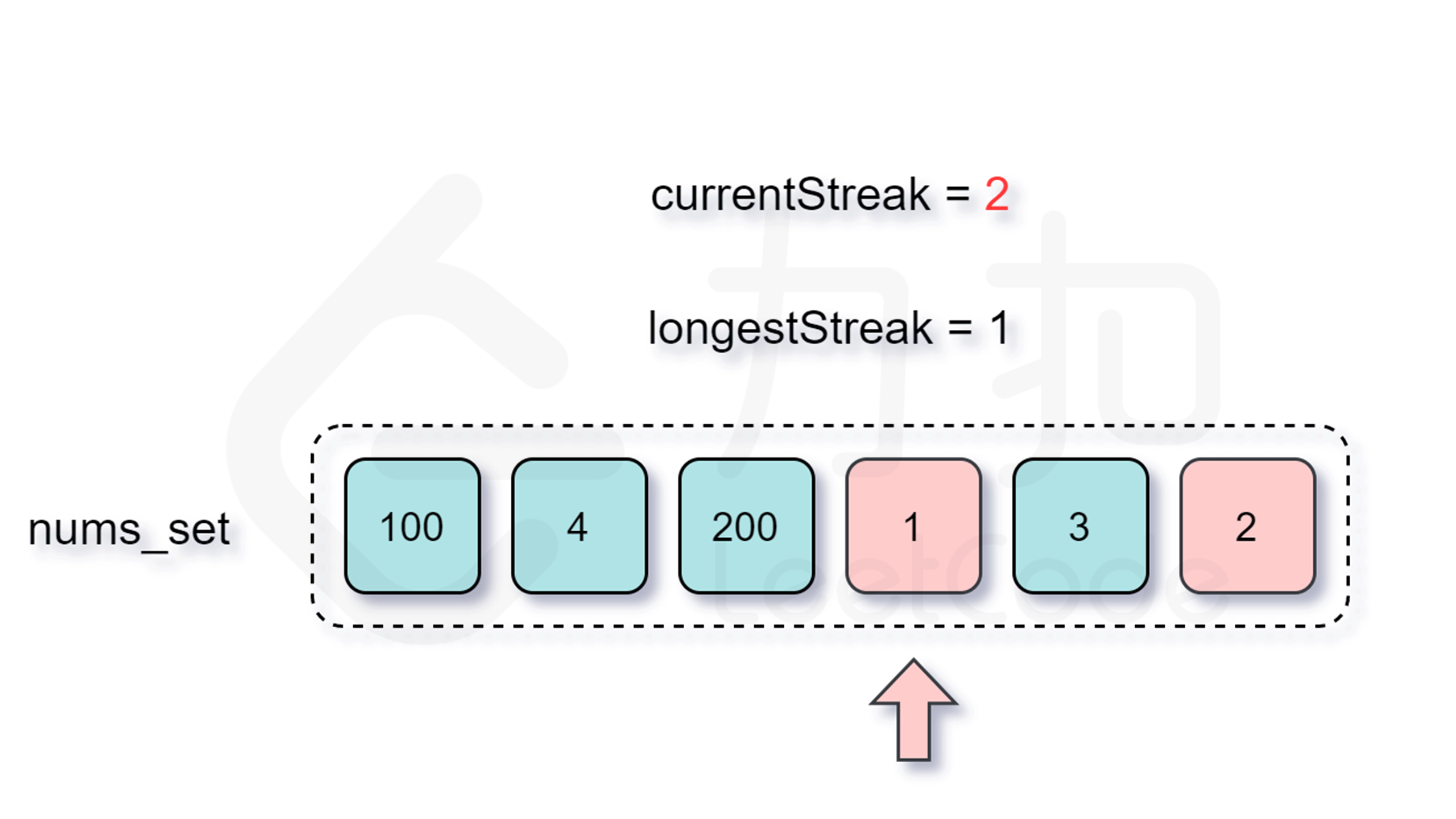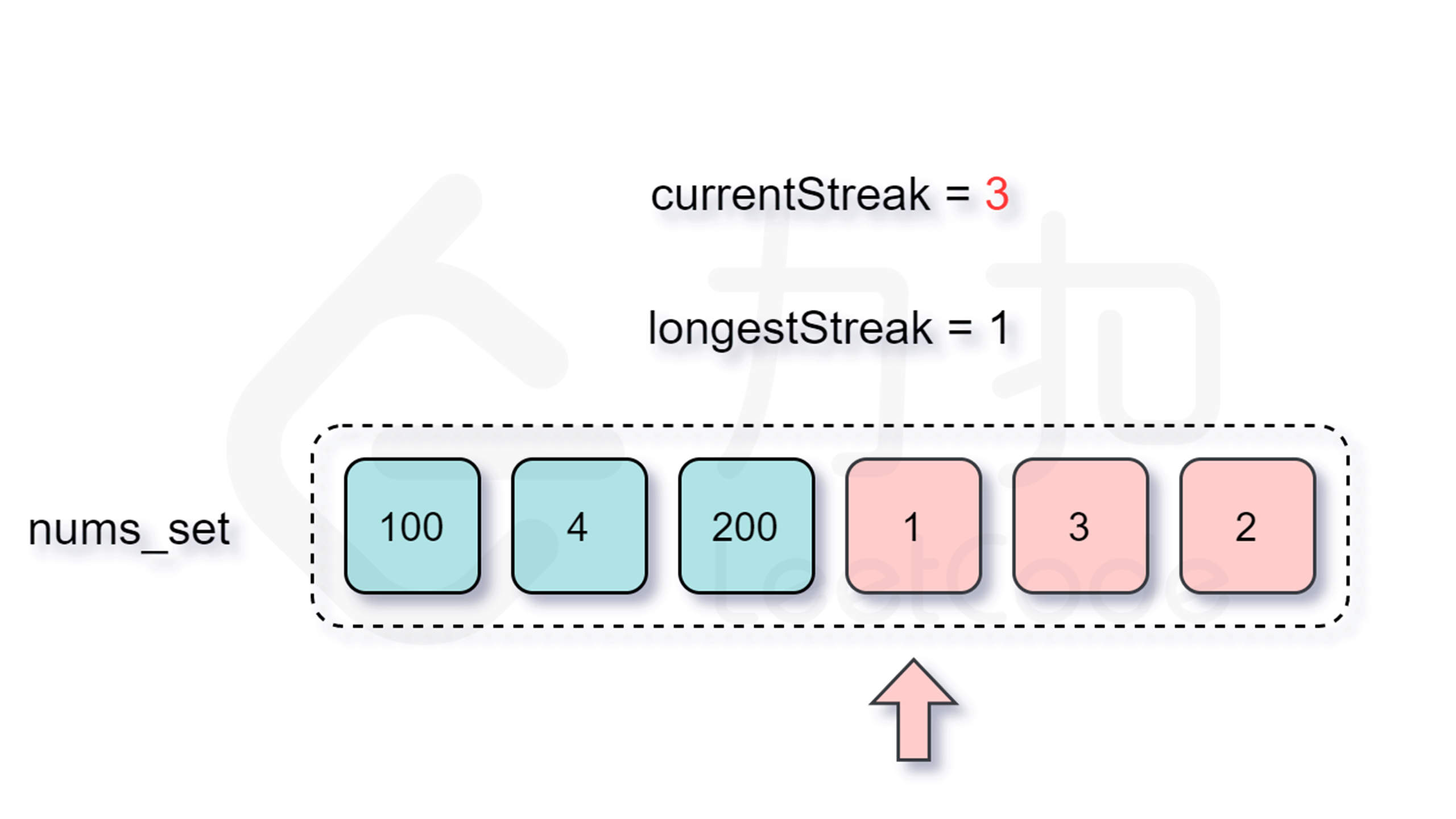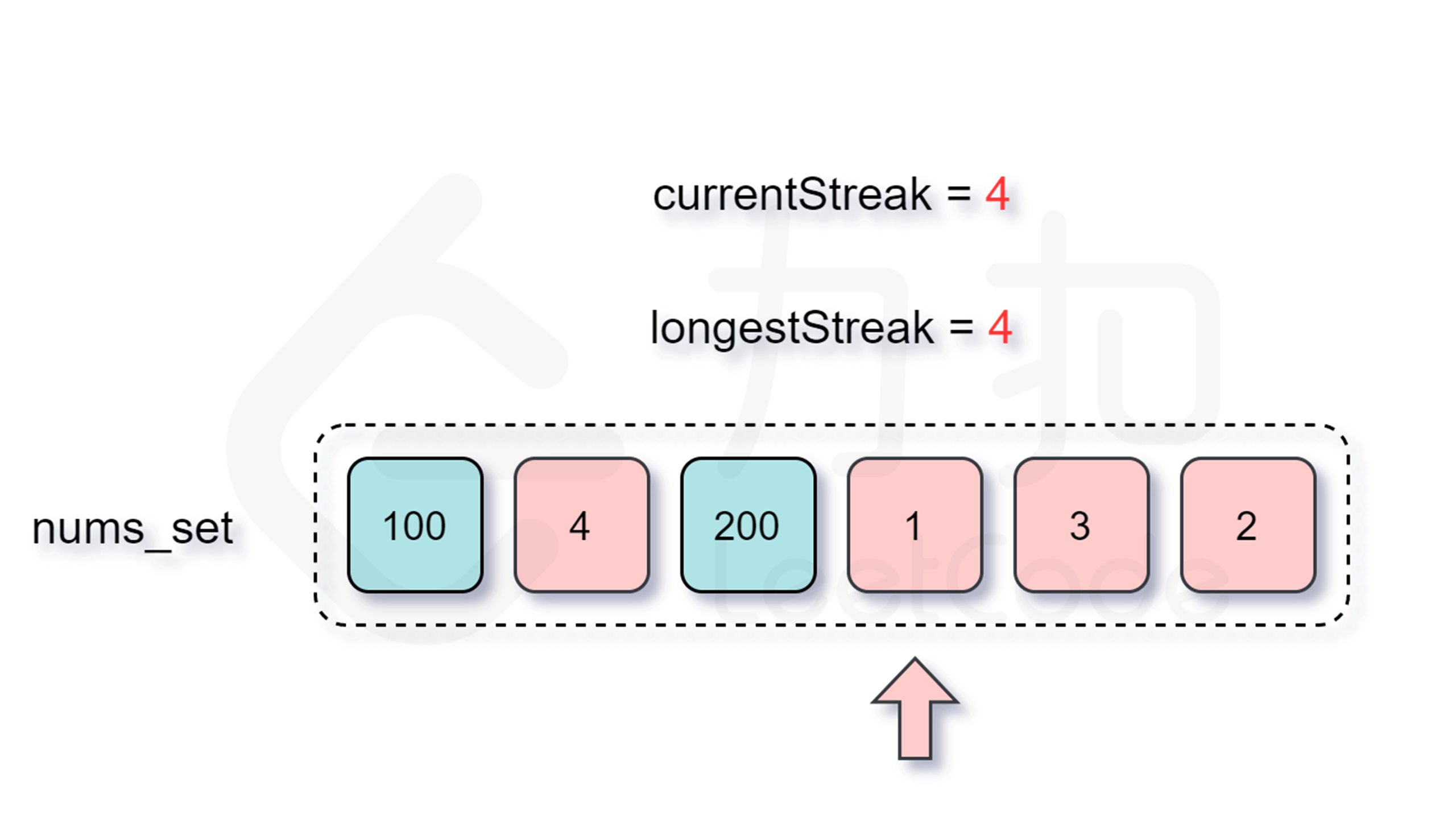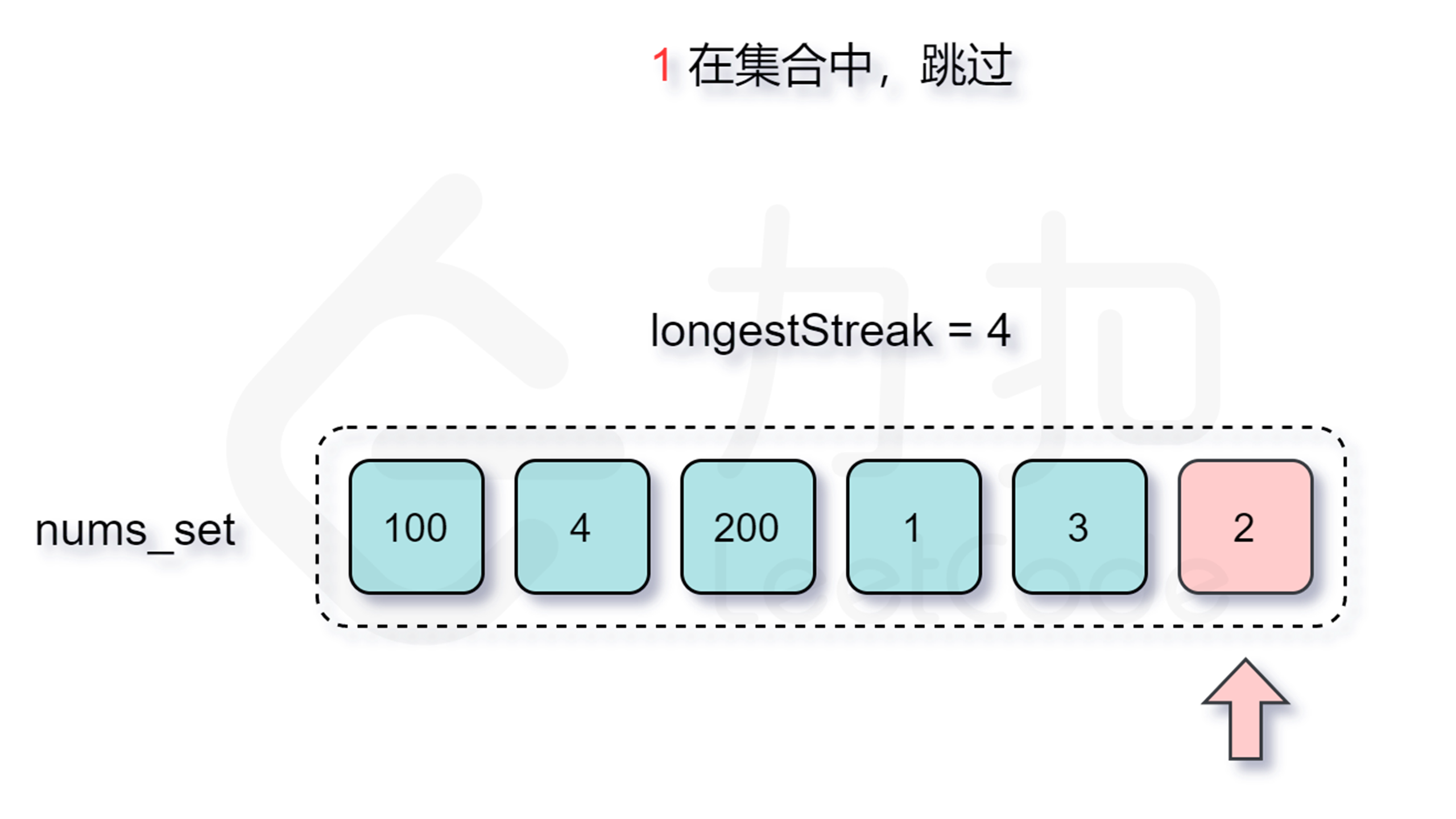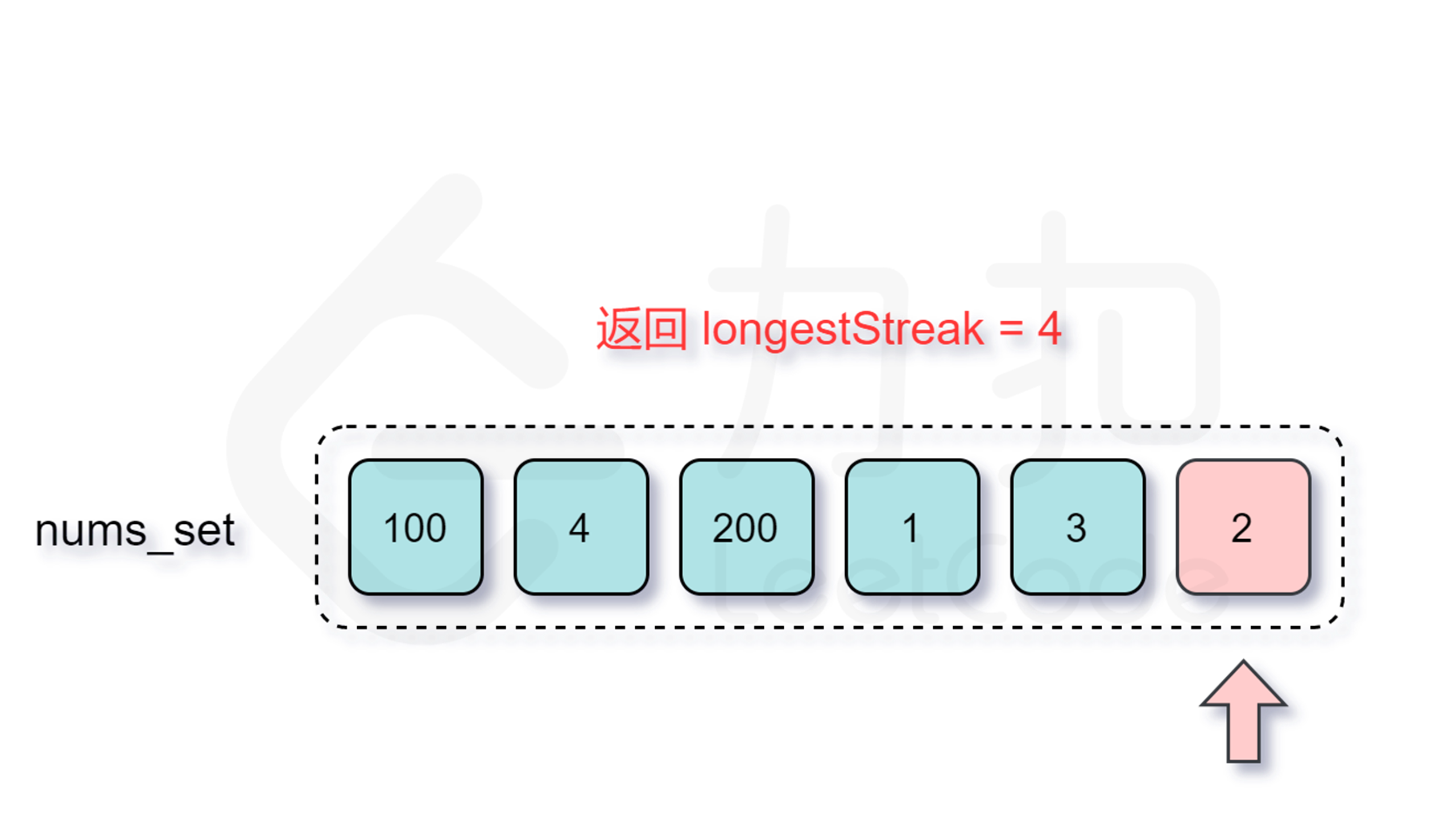给定一个未排序的整数数组 nums ,找出数字连续的最长序列(不要求序列元素在原数组中连续)的长度。
示例 1:
**输入:** nums = [100,4,200,1,3,2]
**输出:** 4
**解释:** 最长数字连续序列是 [1, 2, 3, 4]。它的长度为 4。
示例 2:
**输入:** nums = [0,3,7,2,5,8,4,6,0,1]
**输出:** 9
提示:
0 <= nums.length <= 104-109 <= nums[i] <= 109
进阶: 可以设计并实现时间复杂度为 O(n) __ 的解决方案吗?
注意:本题与主站 128 题相同: <https://leetcode-cn.com/problems/longest-consecutive-
sequence/>
方法一:哈希表
思路和算法
我们考虑枚举数组中的每个数 x,考虑以其为起点,不断尝试匹配 x+1, x+2, \cdots 是否存在,假设最长匹配到了 x+y,那么以 x 为起点的最长连续序列即为 x, x+1, x+2, \cdots, x+y,其长度为 y+1,我们不断枚举并更新答案即可。
对于匹配的过程,暴力的方法是 O(n) 遍历数组去看是否存在这个数,但其实更高效的方法是用一个哈希表存储数组中的数,这样查看一个数是否存在即能优化至 O(1) 的时间复杂度。
仅仅是这样我们的算法时间复杂度最坏情况下还是会达到 O(n^2)(即外层需要枚举 O(n) 个数,内层需要暴力匹配 O(n) 次),无法满足题目的要求。但仔细分析这个过程,我们会发现其中执行了很多不必要的枚举,如果已知有一个 x, x+1, x+2, \cdots, x+y 的连续序列,而我们却重新从 x+1,x+2 或者是 x+y 处开始尝试匹配,那么得到的结果肯定不会优于枚举 x 为起点的答案,因此我们在外层循环的时候碰到这种情况跳过即可。
那么怎么判断是否跳过呢?由于我们要枚举的数 x 一定是在数组中不存在前驱数 x-1 的,不然按照上面的分析我们会从 x-1 开始尝试匹配,因此我们每次在哈希表中检查是否存在 x-1 即能判断是否需要跳过了。
< ,
, ,
, ,
, ,
, ,
, ,
, ,
, ,
, ,
, ,
, ,
, >
>
增加了判断跳过的逻辑之后,时间复杂度是多少呢?外层循环需要 O(n) 的时间复杂度,只有当一个数是连续序列的第一个数的情况下才会进入内层循环,然后在内层循环中匹配连续序列中的数,因此数组中的每个数只会进入内层循环一次。根据上述分析可知,总时间复杂度为 O(n),符合题目要求。
[sol1-Java]1
2
3
4
5
6
7
8
9
10
11
12
13
14
15
16
17
18
19
20
21
22
23
24
25
26
| class Solution {
public int longestConsecutive(int[] nums) {
Set<Integer> num_set = new HashSet<Integer>();
for (int num : nums) {
num_set.add(num);
}
int longestStreak = 0;
for (int num : num_set) {
if (!num_set.contains(num - 1)) {
int currentNum = num;
int currentStreak = 1;
while (num_set.contains(currentNum + 1)) {
currentNum += 1;
currentStreak += 1;
}
longestStreak = Math.max(longestStreak, currentStreak);
}
}
return longestStreak;
}
}
|
[sol1-Python3]1
2
3
4
5
6
7
8
9
10
11
12
13
14
15
16
17
| class Solution:
def longestConsecutive(self, nums: List[int]) -> int:
longest_streak = 0
num_set = set(nums)
for num in num_set:
if num - 1 not in num_set:
current_num = num
current_streak = 1
while current_num + 1 in num_set:
current_num += 1
current_streak += 1
longest_streak = max(longest_streak, current_streak)
return longest_streak
|
[sol1-C++]1
2
3
4
5
6
7
8
9
10
11
12
13
14
15
16
17
18
19
20
21
22
23
24
25
26
27
| class Solution {
public:
int longestConsecutive(vector<int>& nums) {
unordered_set<int> num_set;
for (const int& num : nums) {
num_set.insert(num);
}
int longestStreak = 0;
for (const int& num : num_set) {
if (!num_set.count(num - 1)) {
int currentNum = num;
int currentStreak = 1;
while (num_set.count(currentNum + 1)) {
currentNum += 1;
currentStreak += 1;
}
longestStreak = max(longestStreak, currentStreak);
}
}
return longestStreak;
}
};
|
[sol1-TypeScript]1
2
3
4
5
6
7
8
9
10
11
12
13
14
15
16
17
18
19
20
21
22
23
24
| var longestConsecutive = function(nums: number[]): number {
let num_set: Set<number> = new Set();
for (const num of nums) {
num_set.add(num);
}
let longestStreak = 0;
for (const num of num_set) {
if (!num_set.has(num - 1)) {
let currentNum = num;
let currentStreak = 1;
while (num_set.has(currentNum + 1)) {
currentNum += 1;
currentStreak += 1;
}
longestStreak = Math.max(longestStreak, currentStreak);
}
}
return longestStreak;
};
|
[sol1-Golang]1
2
3
4
5
6
7
8
9
10
11
12
13
14
15
16
17
18
19
20
21
| func longestConsecutive(nums []int) int {
numSet := map[int]bool{}
for _, num := range nums {
numSet[num] = true
}
longestStreak := 0
for num := range numSet {
if !numSet[num-1] {
currentNum := num
currentStreak := 1
for numSet[currentNum+1] {
currentNum++
currentStreak++
}
if longestStreak < currentStreak {
longestStreak = currentStreak
}
}
}
return longestStreak
}
|
复杂度分析






